SATURDAY
SEPTEMBER 30 - 2017
Langstone
Mill Pond
Peter
Milinets-Raby has had two brief outings to Langstone
Mill Pond recently as follows:
Wednesday 27th September:
Noon to 1:38pm - in along Wade Lane: The highlight was
a Firecrest in the garden of the house opposite
the "castle" (see photo), along with a fairly tame
Rabbit (see photo). Also seen were a Goldcrest,
a Grey Wagtail and a Chiffchaff. On the pond were 2
eclipse Shoveler (male and female) and off shore on
the mud were 11 Sandwich Tern and 2 Dunlin.
Friday 29th
September:
9am to 9:38am - tide going out. The highlight were
2 Green Sandpiper in the partially flooded
paddock (see photo). The bird close to the camera was
a spotty juvenile, with the second bird being a darker
and larger adult. Both birds were flighty and gave
good views as they flew around the paddock visiting
all the fresh pools of water from last nights heavy
rain.

Off shore were 10
Black-tailed Godwits, a single Bar-tailed Godwit, a
Dunlin, 178+ Redshank and 6 resting Sandwich Terns. On
the pond were 29 Teal (a bit of an increase from the
last few days), along with 4 juvenile Tufted Duck, a
Chiffchaff and a singing Cetti's Warbler was heard
several times.
FRIDAY
SEPTEMBER 29 - 2017
Autumn
flowers
I had a gentle
stroll through Brook Meadow and down to Peter Pond on
this rather dank and dismal morning with rain
constantly in the air. I kept myself occupied by
making a list of the flowering plants I came across on
the way. Here is the complete list of 46 plants
(including 4 grasses) in alphabetical order.
Annual Meadow-grass, Autumn Hawkbit, Bristly
Ox-tongue, Broad-leaved Willowherb, Cat's-ear,
Cocksfoot, Common Chickweed, Common Comfrey, Common
Field Speedwell, Common Fleabane, Common Nettle,
Common Reed, Creeping Thistle, Daisy, Dandelion,
Dogwood, False Oat-grass, Groundsel, Hairy Tare
Gooseberry Cottage path), Hedge Bindweed, Hoary
Ragwort, Hogweed, Ivy-leaved Toadflax, Large Bindweed,
Lesser Stitchwort (Bridge Road car park), Michaelmas
Daisies, Nipplewort, Pellitory-of-the-wall (Bridge
Road car park), Perennial Sow-thistle, Prickly
Sow-thistle, Purple Toadflax, Red Clover, Red
Dead-nettle, Red Valerian, Ribwort Plantain, Russian
Vine (Seagull Lane), Shepherd's Purse, Smooth
Sow-thistle, Wall Lettuce (Bridge Road car park),
Water Bent (Victoria Road), Water Mint (Brook Meadow),
Wavy Bitter-cress, White Dead-nettle, Wild Angelica,
Wild Carrot, Yarrow.
Here
are a few I snapped: Creeping Thistle, Red Clover, Red
Dead-nettle, Water Mint
Insects included a
couple of Red Admirals on the Michaelmas
Daisies on the Lillywhite's patch - here is one of
them that I snapped. And a solitary Ladybird (possibly
24-spot).
There were lots of
Nursery-web spiders on the nettle leaves, as usual,
including this one - surely not taking on a shelled
snail?
. . . and a Garden Spider suspended on its web high
above Peter Pond. How does it get its web up there?
THURSDAY
SEPTEMBER 28 - 2017
Emsworth
Harbour
It was a
superb morning so I set off for the harbour with my
scope strapped to the back of my bike. I started at
the millpond, where I happened to meet Susan Kelly who
was delighted to tell me that her book on the travels
of a medieval monk named Willibaum (I think) had been
nominated for a literary prize which will enable her
to get it published. Well done, Susan. I promise to
get a copy!
I had intended to go along Western Parade to Nore
Barn, but from the millpond seawall I could see lots
of birds on the far side of the harbour, so I decided
to make my way over there. The tide was out, but being
a neap tide the water was still fairly high.
Got to the marina
seawall at 11am with a great view across the harbour
to the village
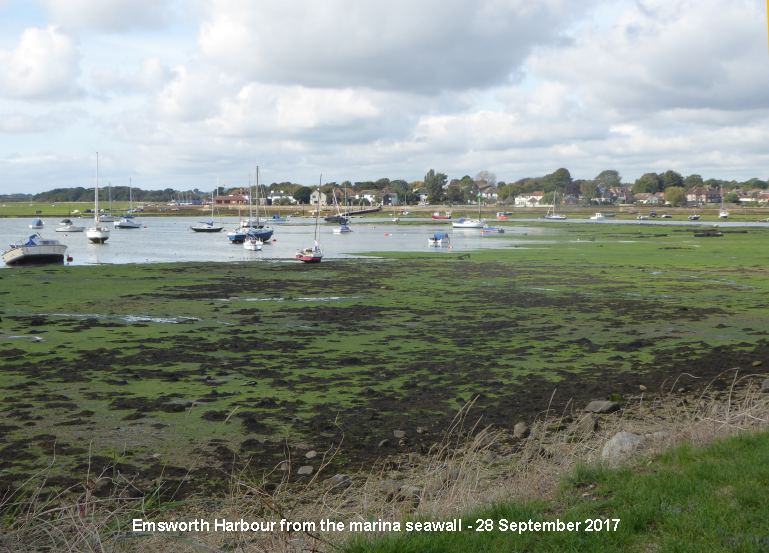
I counted 75
Black-tailed Godwits, 95 Redshank, 7 Greenshank, 9
Oystercatchers, 4 Dunlin, 19 Turnstones, 2 Curlew and
1 Grey Heron. There was no sign of any Brent Geese as
yet, though Ralph Hollins has seen them in Langstone
Harbour. They always take their time to come into
Emsworth Harbour.
Turnstones packed
closely together on a red buoy
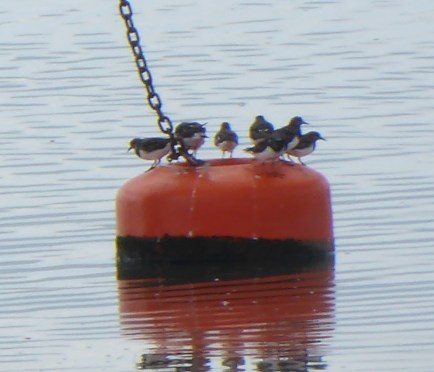
I did not see any
colour-ringed Godwits, but their legs were not always
visible
Black-tailed Godwits with Redshanks and Black-headed
Gulls
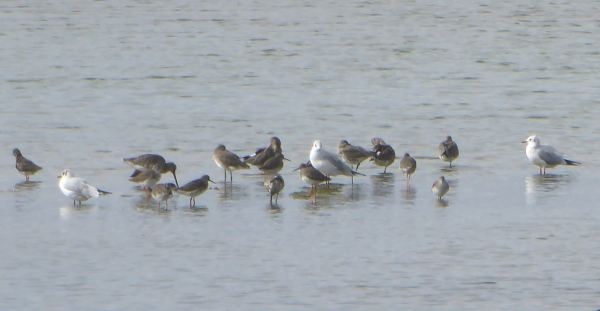
The 7
Greenshank were all in the low water channel
near the marina entrance
Here are three of them together.

Five of them were
colour-ringed, but I could only read two of the colour
rings completely as the others were either standing on
one leg with the other tucked up or were partly in
water.
G+BL - This is a regular in Emsworth Harbour
since 2014. It used to have a geotag, but I could not
see one today, so I assume it has been removed for
analysis in a recatch of the bird.
RG+BY - I have seen this Greenshank regularly
in Emsworth Harbour since 2013 when it was caught at
Thorney and fitted with a geolocator to the blue
rings. This is probably another case where the tag has
been removed for analysis.
This one could be
OO+YY which has been seen in Emsworth Harbour over the
years
I did not see the other leg
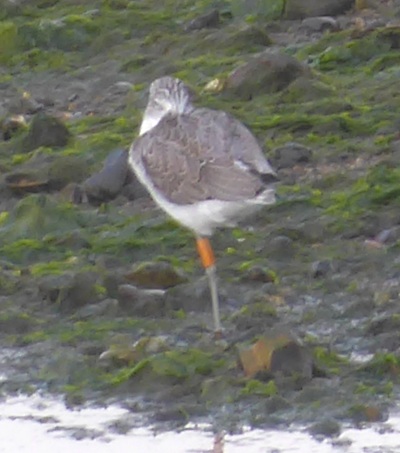
While I was looking at
the Greenshank a Kingfisher flew across the channel.
Black Medick and Hedgerow Crane's-bill were in flower
on the marina seawall. I had my coffee break sitting
at one of the two picnic tables on the marina seawall
overlooking the harbour eating a chunk of Jean's
superb apple cake. Cheers!

TUESDAY
SEPTEMBER 26 - 2017
Nore
Barn
I cycled over
to Nore Barn to catch the rising tide this afternoon.
The conditions were calm and still, but there was
hardly anything about on the bird front. A Common
Redshank and a few Black-headed Gulls were present in
the stream, but no sign of Spotted Redshank. However,
it is still quite early for the regular bird which was
not here until 11 Oct last year. The regular Little
Egret was also present in the stream feeding in its
characteristic manner with the tip of its bill dipped
into the water.
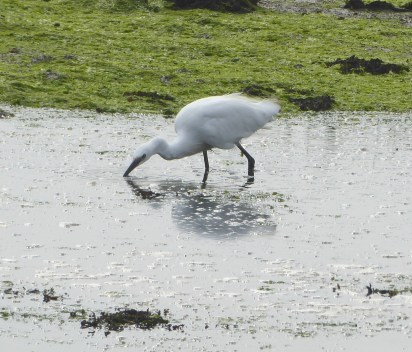
The arrival of a
second Little Egret caused some consternation and it
was quickly chased off by the resident Egret,
presumably to protect its feeding territory.
I stopped to have a
chat with Nick and a colleague from Norse who were
engaged in cutting the grassland in the woods. They
had two machines, one for mowing the grassland and the
other for collecting and taking away the arisings to a
composting site. This was interesting since earlier
this month Nick had cut the grassland on Brook Meadow,
but the arisings were left on the site. Nick explained
that the problem was the difficult access for the
truck and trailer through the narrow Lumley gate.

I also chatted to Roy
Ewing who had come to have a look at the grass cutting
and to mark some shrubs along the north path that were
due to be cut by Rachel Bryan of TCV. I asked him to
keep a look out for the Spotted Redshank.
MONDAY
SEPTEMBER 25 - 2017
Emsworth
walk
This afternoon
I had a stroll through Brook Meadow down to Slipper
Millpond and back via the town millpond. Nothing to
note on Brook Meadow, but the large area of
Michaelmas Daisies on the Lillywhite's patch,
immediately south of the garden of Gooseberry Cottage,
is now in flower; these flowers always attract late
butterflies, but there were none today.

On Lumley Road, I
stopped to chat with workers inserting stakes to
reinforce the banks of the small stream that runs into
the east side of Peter Pond. Some of them were
ex-volunteers from Hollybank Woods, now working in
Barton's Copse near the Havant Crematorium, from where
the stakes were sourced.
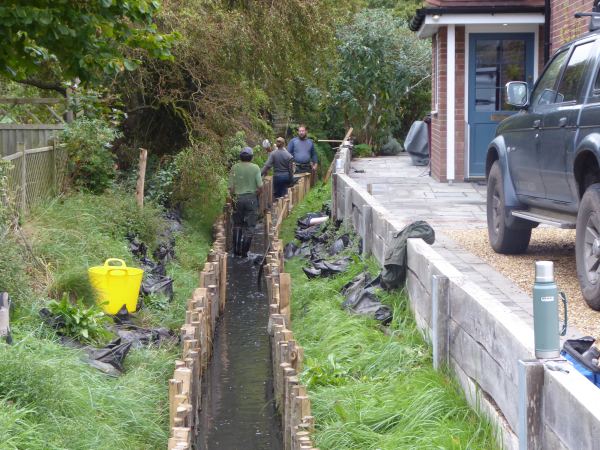
The Mute Swan
family with mum and 5 cygnets was on the water
near the Hermitage Bridge, but no sign of the cob.

I also did not see the
other Mute Swan pair that has been hanging around the
area. Sharon, who lives in Slipper Road opposite
Slipper Millpond, rang me last night to say she had an
adult swan ensconced on the road outside her house,
presumably one of the 'intruders' that had been driven
off the pond by the resident pair. Sharon had tried to
coax the swan into the pond, but it would not budge. I
did not hear the outcome of this story.
Deep orange Sea
Buckthorn berries are now on the bush at the far
end of Slipper Road on the east side of Slipper
Millpond.
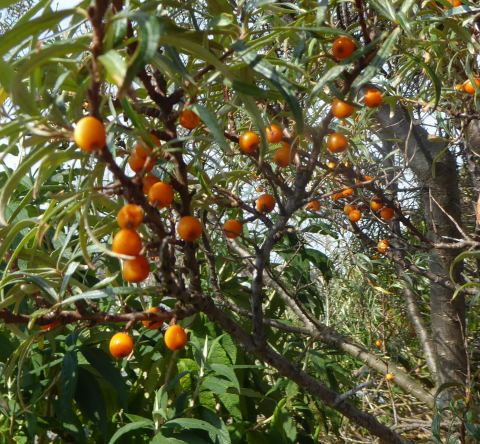
Slipper Millpond and
the town millpond (shown below) are currently covered
with large patches of green algae. These are sometimes
regarded as pollution, but they are in fact naturally
occurring growths at this time of the year and most
ponds have such growths. The harbour is also full of
it. Strictly speaking, algae are not plants; they can
photosynthesise, but they lack true roots, stems or
leaves.
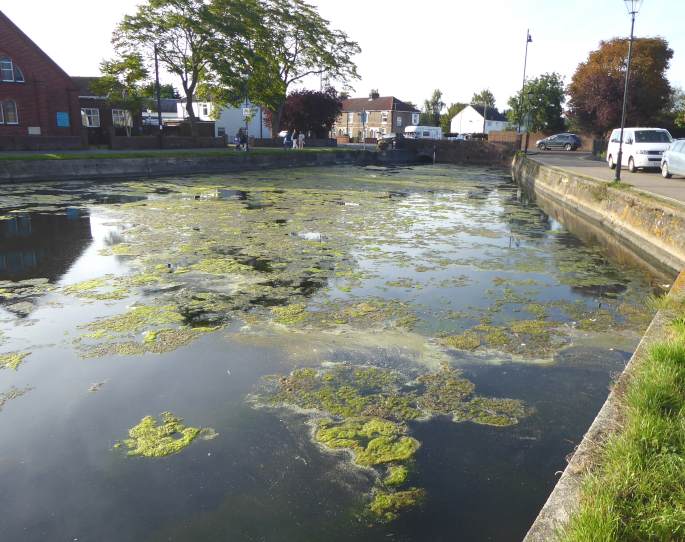
Dolphin
Lake path
I had a walk
along the public footpath on the west side of Dolphin
Lake which used to be one of the Emsworth Waysides.
The land alongside the path is owned by the Wardle
family who used to live in Wharf House at the far end
of the lane on King Street. Mr and Mrs Wardle (now
deceased) bought the land on the west side of Dolphin
Lake to conserve it as a wildlife area and they were
delighted to have it included in the Emsworth Waysides
scheme.
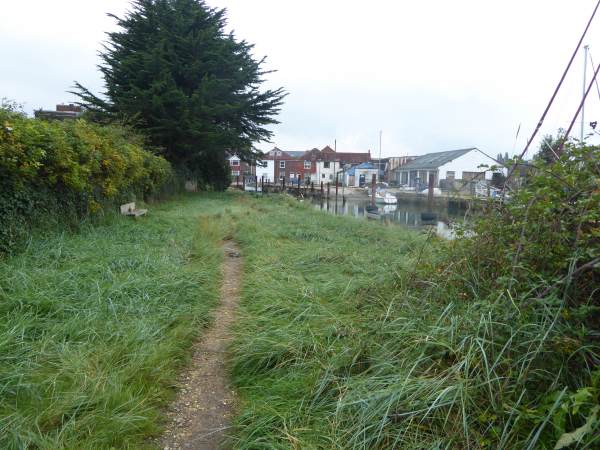
I was interested to
read in the current Newsletter of the Slipper Millpond
Preservation Association that in view of the impending
development on the old Dolphin Quay site, the two
Wardle daughters want to ensure that the strip of land
bought by their parents remains a 'public open space'
and have offered the land as a gift to the Slipper
Millpond Preservation Association. The offer will be
formally considered at the next SMPPA AGM on Oct 27th.
Grey
Seals
John Arnott,
who has provided useful and interesting information
about Seals recently in this blog, will be guiding on
a Chichester Harbour Conservancy boat trip from
Itchenor to look at the Seal haul out on 30th
September at 12 noon for 3 hours.
See . . . http://www.conservancy.co.uk/events/view/1918/wildlife-discovery-on-the-solar-heritage-itchenor
John is also giving a
presentation about the seals for the Conservancy on
21st October 15.30 to 17.00 at the Hayling Island
Lifeboat Station.
See . . . http://www.conservancy.co.uk/events/view/1931/seals-in-chichester-and-langstone-harbours
Booking is essential
for both events . . . 01243 513275
SUNDAY
SEPTEMBER 24 - 2017
Warblington
shore
Peter
Milinets-Raby had a 'Red Letter Day' down Warblington
shore this morning from 7:06am to 9:21am - Low tide
and a beautiful sunny morning. Here is Peter's report:
On arrival I could
hear a Chiffchaff singing from the cemetery.
I walked down to the shore by Pook Lane and one of the
first birds I noticed as I scanned the low tide
trickle in the channel was a single Avocet (a
good species for the area, with just a few sightings).
Seeing this bird put me in good spirits and a small
flock of 8 duck drifting in from North Hayling turned
out to be Wigeon. They settled down to the east at
Conigar Point. Next, a group of 7 Cormorants dropped
into the low tide channel and fed as a pack dashing
through the shallow water, with lots of splashes etc.
On further scans, I added 15 Grey Plover, 1
Black-tailed Godwit, 2 Ringed Plover, a Bar-tailed
Godwit and 5 Greenshank. Then a Snipe flew over
heading east, calling as it did so (another scarce
species in the area). Plus 15 Little Egrets and 3 Grey
Heron feeding in the "stream"
Migrational
movement was obvious all morning with an almost
constant stream of Meadow Pipits passing over (I heard
7+ and actually managed to see 7 birds fly over in the
blue, cloudless sky). Also observed 2 Pied Wagtails
over, along with two heard Yellow Wagtail, 3+ Linnets,
3 House Martin and 11+ Swallows.
Conigar Point held 13 Teal, 2 more Grey Plover, 3
Dunlin and in the splendid blossomed Tamarisk
Hedge were at least 3 Chiffchaff.
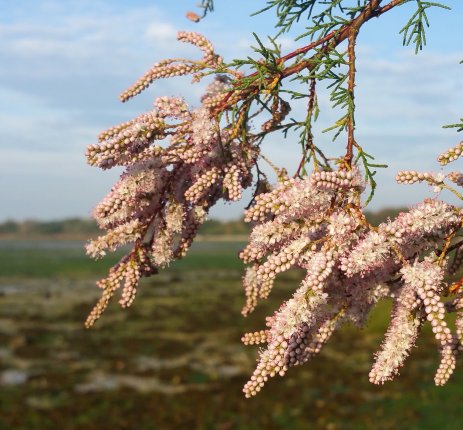
On the way back to the
car, 2 Ravens flew over "kronking" heading west
(only the second sighting I have had of this species).
So all in all a great morning, but then the icing on
the cake occurred when I noted a Wryneck
skipping along the coastal path by the main "Kissing
Gate". It was heading away from me, very busy nipping
into the grass verge of the path and then skipping
further away from me. I held my ground, as a dog
walker and a jogger were fast approaching the Wryneck
and I was intrigued to see what the Wryneck would do?
The jogger arrived first and the Wryneck dashed off
out over the low tide mud and I thought that was it,
but fortunately it curved around and headed back to
the path and landed less than 20 feet away from me.
Alas, I was looking straight into the sun and cursed
the silhouetted photos I had to take! However with a
bit of jiggling on Photoshop, the photos are not bad.

The dog walker alas
caught me up and flushed the Wryneck into the nearby
hedge. I waited 15 minutes before it appeared. It
perched on the top of the hedge for a minute or so
before flying off across the field into the hedge that
leads south of the Warblington cemetery. I hung around
for 15 minutes with no further sightings. It could
well be in the same area, but the habitat is a bit
sparse and not conducive for keeping migrants put. So
a wonderful way to finish off a lovely Red Letter
Day
SATURDAY
SEPTEMBER 23 - 2017
More
on Grey Seals
Following his
comment about the difference between Harbour (Common)
Seals and Grey Seals in blog entry for Sep 21, John
Arnott provides more information about Grey Seals in
the Solent area as follows . . .
"Just four years ago
one might expect to see one or two Greys. They've been
slowly increasing since then and this August our count
was eight, the greatest number so far. They are
increasing in their traditional rookeries down the
east coast of England and the annual count in the
Greater Thames Estuary carried out in August by the
Zoological Society of London found a jump from 203 in
2013 to 449 in 2014 with 454 in 2015, while the number
of Common seals stayed about the same (482, 489 and
451). The National Trust at Blakeney Point, Norfolk,
reckon that Grey seals have reached capacity
there.
See . . . https://www.nationaltrust.org.uk/news/blakeney-point-remains-largest-grey-seal-colony-in-england
So I suspect that we
are seeing the edge of an advancing front of Grey
seals into the Solent area from the east, maybe of
younger animals. Will they compete with our local
population of breeding Common/Harbour seals? Not in
these low numbers, though declines in populations of
Common seals in Scotland may be due to competition
from and even predation by Greys.
There is definitely
one female Grey in our area and at least four of the
male Greys have been bickering amongst themselves and
showing mating interest in her. I've attached a photo
from last month's count showing a male Grey Seal
(darker with some pale blotches) trying to mount the
female Grey Seal (paler with some dark blotches). She
wasn't interested though and because the male is about
the same size as her I think he is still relatively
young. Male (bull) Greys are some 50% bulkier than
females when sexually and socially mature - not much
longer but with 50% more weight. And yes, he has a
small bit of skin scraped off his back.
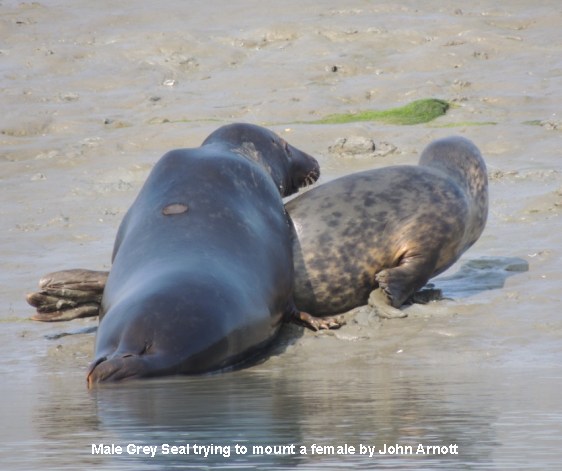
Grey seal pups are
unable to swim for the first three weeks of their
lives (there are exceptions) while they are covered
with long white fur, so pupping is usually in remote
areas such as islands, rocky coves or the 4 mile long
shingle spit of Blakeney Point. Neither Chichester
Harbour or Langstone Harbour offer such remote and
safe locations. If this female does get pregnant she
may leave our area to search for a safer pupping spot.
But you never know . . ."
Bee-fly
correction
Bryan Pinchen
says the 'Bee-fly' photo from Romney Turner in the
blog for Sep 21 was is actually the hoverfly Myathropa
florea, easily told even from the side angle by the
pattern of yellow hairs on the thorax. Thanks Bryan.

Medmerry
RSPB Reserve
Tony Wootton reported on this morning's walk by the
Havant Wildlife Group at Medmerry.
For full report and photos see . . . Havant
Wildlife Group
FRIDAY
SEPTEMBER 22 - 2017
Nore
Barn
I cycled down
to Nore Barn by 11am with the tide rising to high
water in 2½ hours. It was a lovely morning, a bit
bright, but calm. I stayed for about an hour as the
tide slowly filled up the stream. Two Common
Redshanks were feeding at various times, but no
sign of Spotted Redshank. Here is one of the Common
Redshanks.
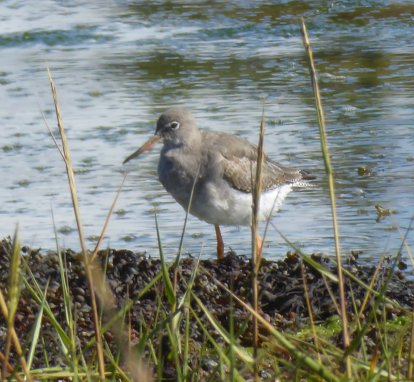
I think the two
Spotted Redshank sightings by Anne de Potier and Peter
Milinets-Raby a couple of weeks ago was a rogue bird
stopping by on passage further south. On the basis of
previous first arrival dates I would not expect the
regular bird to arrive until the beginning of
October.
All previous arrival dates are on the special Spotted
Redshank web page at . . . Spotted
Redshanks at Nore Barn
I chatted to people
passing by, several of whom asked about the Spotted
Redshank, if it had arrived, when it was expected, how
long it had been coming here and where it comes from.
It is indeed a truly famous bird!
The most interesting
sighting of the morning was of a small group of 10 or
so ducks way out on the edge of the main channel. I
did not have my scope, so could not see them clearly,
but felt fairly sure they wereTeal which always arrive
before Wigeon. They are probably the same group of
Teal that Peter Milinets-Raby saw at Conigar Point
yesterday - see his report below. Here is a shot of a
few of them with my camera on its full 30x zoom.
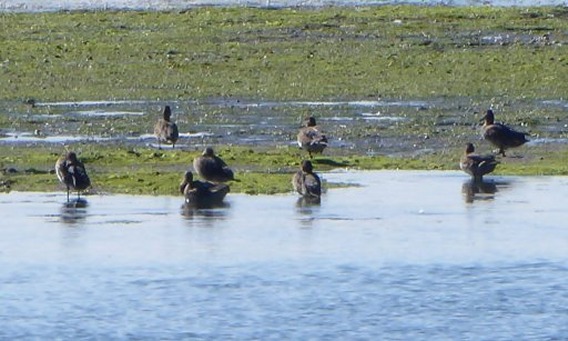
Warblington
shore
Yesterday (Sep
21), Peter Milinets-Raby had a couple of hours free
from 9am, so quickly visited the Warblington shore
along with Nore Barn before the tide pushed in. His
report follows:
"Over the Ibis field,
I had a Sparrowhawk, followed by a very mobile
Peregrine that flushed all the pigeons and doves, then
it headed to the shore where it no doubt flushed
everything else, especially as I saw very little when
I reached the shore.
Just before reaching the shore by Conigar Point a
Hobby flew over, so some great birds of prey to start
the outing, but consequently no birds to bee seen!
Conigar Point as expected held just 10 Teal.
And off Pook Lane, very little else, 4 Dunlin, 1
Bar-tailed Godwit, 2 Black-tailed Godwit and 4
Greenshank. A pre-roost gathering of 13 Sandwich Terns
were on the mud , with a single bird fishing off
Conigar Point.
At Nore Barn (from 10:30am for 30 minutes) were 6
Teal, a Shelduck and the usual Greenshank (R//G +
GL//-). Also 3 Sandwich Tern were seen - probably
coming from Pook Lane, but not certain!
THURSDAY
SEPTEMBER 21 - 2017
Brook
Meadow
I spent most
of the morning on Brook Meadow taking photos of the
regular 3rd Thursday in the month work session led by
Mike Probert. 12 people attended and their main tasks
were clearing arisings from the orchid area, which was
cut during the previous work session, and trimming
branches from a toppling willow near Beryl's seat.
For a full report of
the work session plus more photos go to . . .
http://www.brookmeadow.org.uk/conservation-news/
Grey
Seal
John Arnott
writes to say the Seal photo taken by Heather Mills at
Farlington Marshes (Sep 18) is of a Grey Seal. John
attached a couple of his own photos of a Harbour (or
Common) Seal (on the left) and a Grey Seal (on the
right) taken on seal counts in Chichester Harbour.
They show how the head profile of a Grey Seal is flat
topped compared with the Harbour (or Common) Seal
which has a concave profile along the top of the head
and a proportionately shorter snout. Thank you
John.
Here is Heather's
original photo

Mystery
beetle
Bryan Pinchen
confirmed that the beetle photo taken on Brook Meadow
by John Tagg was looked good for Chrysolina
Banksi.
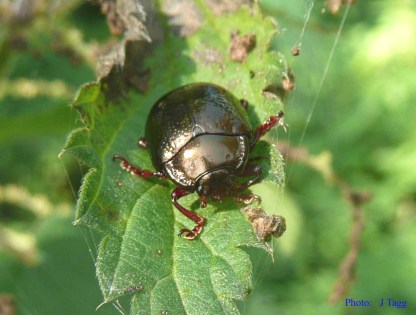
He has been able to
'key it out' using one of his ID guides based on the
features visible in the photo and says there doesn't
seem to be a lot else it could be. Bryan added that it
is considered widespread and common in SW and Central
southern England and Wales, often near the coast where
it feeds on the roots of various plants including
Ribwort Plantain, Black Horehound and White
Dead-nettle. He has seen it on the coast in his area,
so is not surprised it's on Brook Meadow. Thank you,
Bryan.
Kingfishers
Roy Hay got a
cracking, if distant, shot of a pair of Kingfishers at
Fishbourne Meadows this morning. You can just see the
orange colouration on the female's lower mandible on
the left and the all black mandible of the male on the
right.
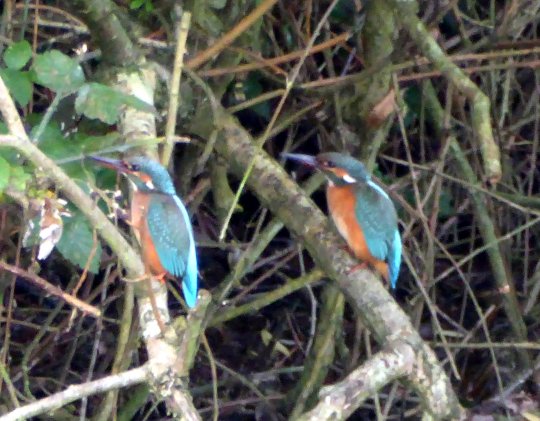
Romney's
wildlife
Romney Turner
sees some interesting wildlife in her garden. Firstly,
she has a regular Wood Mouse which feeds quite
happily at the feeding tray in company with Hedgehogs.
What eyes and what ears! Romney also discovered this
nest of Bank Voles a few years ago.
She also got this
cracking shot of a Bee-fly,
though I don't know which species it is. Can anyone
confirm.
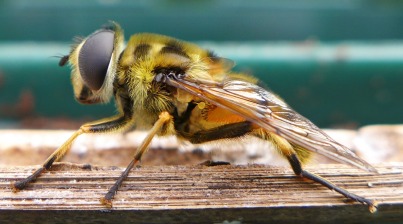
TUESDAY
SEPTEMBER 19 - 2017
Nore
Barn
It was a fine
morning with no wind, so, not having a car at the
moment (my old Citroen ZX died on us during our
holiday break), I opted for a bike ride to Nore Barn.
Arriving at the end of Warblington Road at 9am, I
stayed for about an hour watching the tide slowly fill
the stream, but there was no sign of a Spotted
Redshank. The colour-ringed Greenshank (G+GL)
and 2 Common Redshanks were in the stream much
as usual, but nothing else apart from 6 Mute Swans and
a few Black-headed Gulls.
I am growing in the
view that the Spotted Redshank that Anne de Potier and
Peter Milinets-Raby saw earlier this month was not the
regular one that has been coming here for the past 13
winters. Based on previous years, I would not have
expected it for another week at least. But you never
know. Please keep looking.
Brook
Meadow
I had a walk
through the meadow late morning. Cocksfoot and False
Oat-grass are now flowering with anthers showing.
The young Alder near
the Lumley Stream is looking good and stands about 15
feet high.
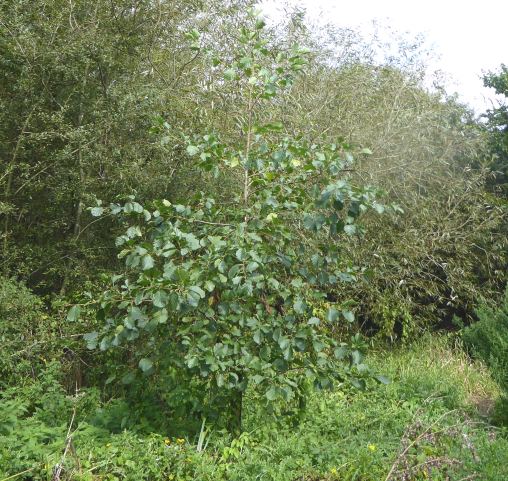
Pepper-saxifrage in
flower attracting an unusual fly
- looks like Graphomya maculata in the
book. .
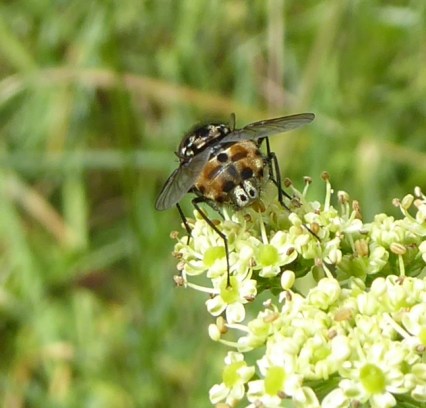
I spotted this lone
hairy caterpillar resting on nettle leaves.
Looks like the larva of either the Grey or Dark Dagger
moth.
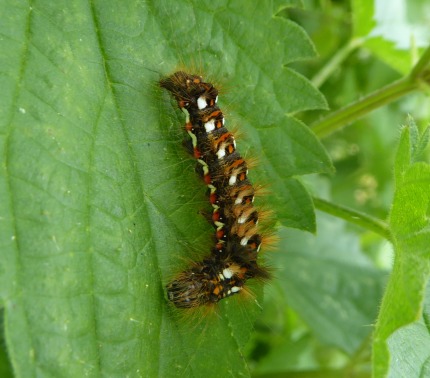
Peter
Pond
The Mute Swan
family with mum and 5 cygnets were preening on the
side of Peter Pond. Lots of white feather indicates
moulting.

I happened to meet
Brendan Gibb-Gray and Debbie both armed with litter
pickers and a bag picking up rubbish along the main
road. Debbie who lives opposite Peter Pond saw the
cygnets flying for the first time this morning.
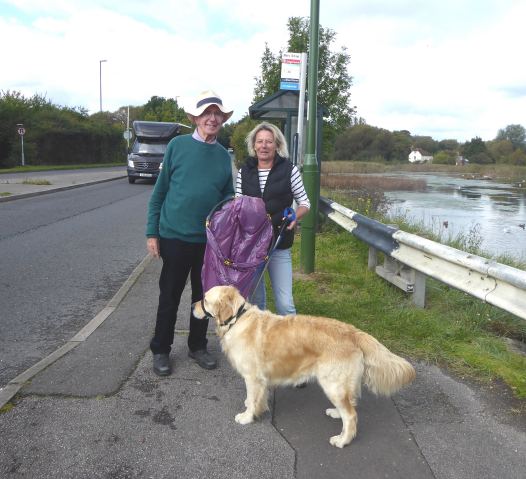
MONDAY
SEPTEMBER 18 - 2017
Langstone
Mill Pond
Peter
Milinets-Raby reports:
"I visited Langstone Mill Pond this morning before the
tide really pushed in to high (8:56am to 9:47am).
The highlights were: Off shore were 5 Greenshank on
the last piece of marsh before the tide covered it,
along with 2 Lapwing, 4 Teal and 3 Sandwich Tern.
On the pond were 8 roosting Little Egrets, 3 Grey
Heron, 4 female and 1 male eclipse plumaged Shoveler,
8 Teal, 2 Tufted Duck juvs, 2+ Chiffchaff and a very
briefly singing Cetti's Warbler (which gave the usual
views as it dived for cover).
Flying over I noted 2 Grey Wagtails, 2 Skylark
(heading Southeast), 2+ Meadow Pipits and 4
Swallow.
Back at the car, I
discovered I had 20 minutes to spare, so armed with my
passport, my inoculation certificate and with all
sharp items safely stowed in the boot, I ventured
across the Hayling Island bridge into unchartered
waters. It took me just four minutes to drive over the
bridge, park and walk the 50 metres to the northern
flooded section of the Oysterbeds where the Grey
Phalarope was showing very well indeed. Also
present were 2 Dunlin, 6 Redshank and 3 House Martins
flew over. And, I managed to arrive home in time for
the windscreen repairman to arrive and sort out the
car (the second time this year!).
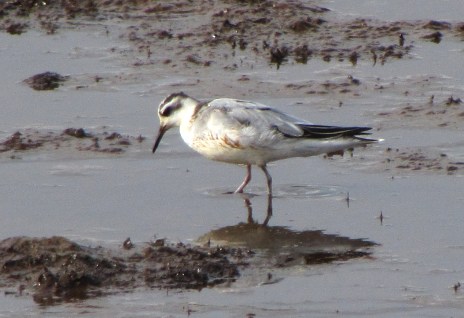
Seal
at Farlington
Heather Mills
was thrilled to see so many Ringed Plover in with
Dunlin off the point at Farlington Marshes during
yesterday's walk with the Havant Wildlife Group. Also,
a Spotted Redshank dropped in at the lake in front of
the hut. However, what really took her by surprise was
a big bull Harbour Seal that swam
nearby.

Mystery
beetle
Eric Eddles
thinks the mystery beetle photo from John Tagg on
Sundays blog looks very much like Chrysolina
Banksi. Thanks, Eric. That looks right to me
too.

Status: widespread,
especially in the south-west, usually coastal, can be
locally common. Habitat: Open, but also valley
woodland. Host plants: Ribwort Plantain, Dead-nettles
and Mints. Over wintering: usually as larvae and as
adults in warmer places. Food: leaves.
SUNDAY
SEPTEMBER 17 - 2017
Emsworth
walk
I went for a
walk this morning through Brook Meadow and down to
Slipper Millpond. It is so good to get out again with
the camera after our short break, even though there is
not a lot to take at the moment. Nursery-web spiders
on Common Nettle leaves. Fresh flowering of False
Oat-grass, not only on Brook Meadow, but also around
Slipper Millpond. Solitary ginger Bumblebee (probably
Bombus pascuorum) feeding on Common Comfrey.
Hoary Ragwort still
looking good on the side of Peter Pond.
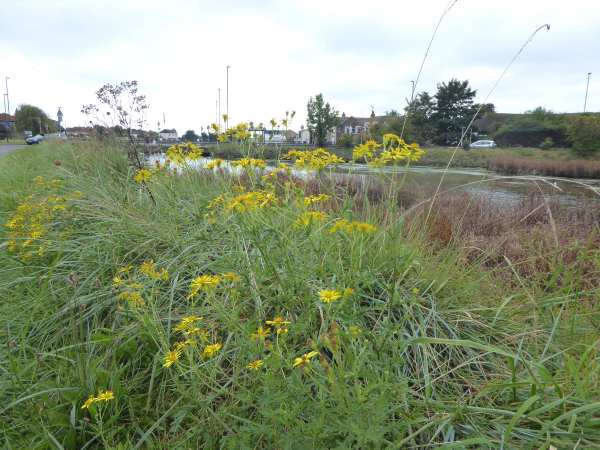
Mute Swan family with
5 cygnets on Peter Pond with a multitude of ducks.
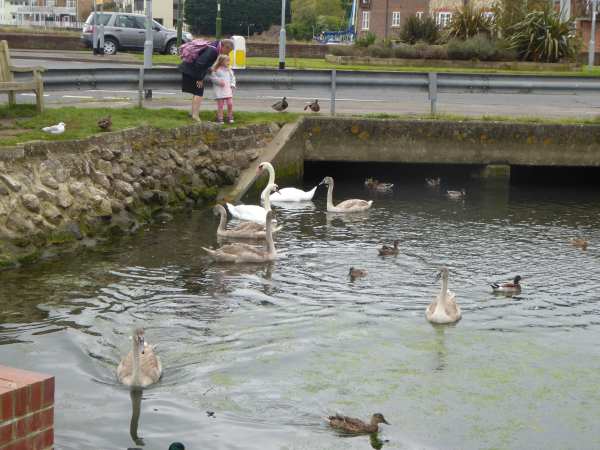
Another pair of Mute
Swans at the top of Dolphin Lake - there could be
trouble ahead?
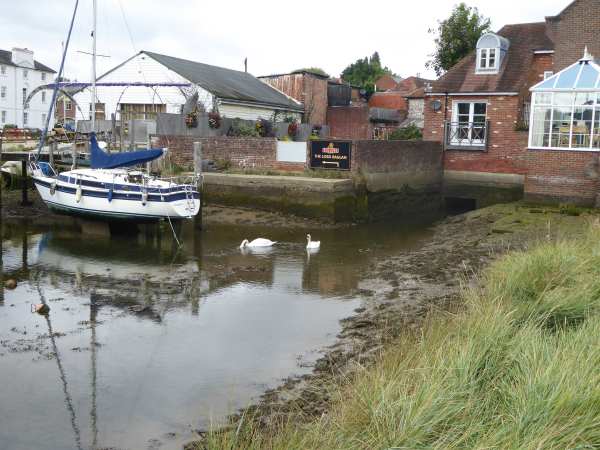
Common Reed in full
flower on the west side of Peter Pond - it flowers
from late July onwards and is said to be the most
widely distributed of all flowering plants in the
world! I picked a few stems for my desk display.
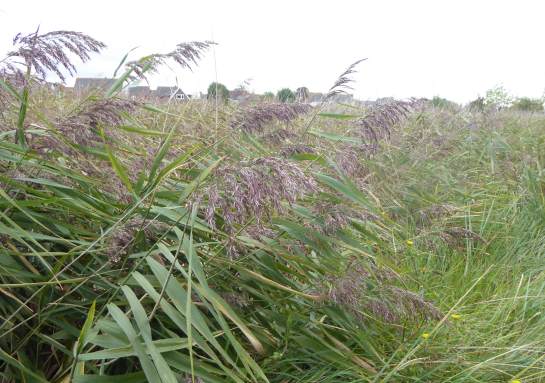
David Gattrell is
making steady progress digging out a new channel
through on the west side of Peter Pond.
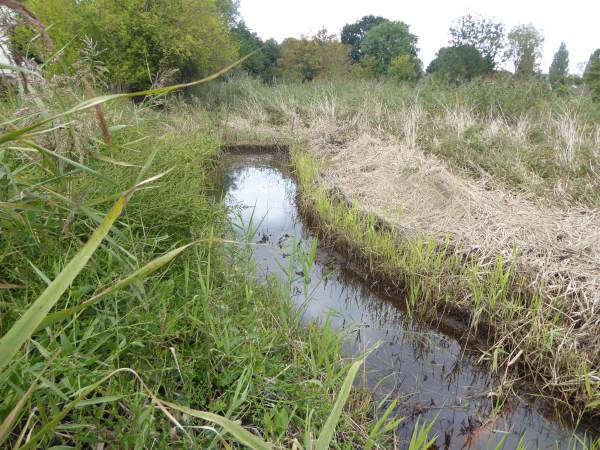
Mystery
beetle
While walking
around Brook Meadow on the morning of Friday 15 Sep,
John Tagg saw what looked like a glint of gold on a
nettle leaf. On closer inspection, he saw that it was
a Beetle with the sun reflecting from its shell, which
appeared to be black. John sent a couple of pictures,
adding that although they show its bright red legs and
hooks on its limbs they do not show just how bright or
gold the reflection was. I can't find it in my book.
Does anyone know what it is?
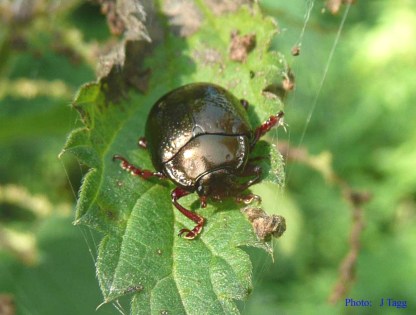
Warblington
shore
Peter
Milinets-Raby reports:
"I was out this morning to check the Warblington shore
before the tide pushed in (6:42am to 8:53am). It was
chilly enough to wear hat and gloves!
The highlights were as follows:
Off Conigar Point:4 Grey Plover, 5 Teal, 1 Bar-tailed
Godwit, 6 Dunlin, 10 Cormorants flying east, 1
Turnstone, 2 Greenshank, 5 Meadow Pipit over, 4 House
Martin over, 6 Little Egrets, 3 Sandwich Tern, 8
Swallow, 68 Oystercatchers at pre-roost gathering on
the "island".
SSSI field: adult and 2 juvenile Whinchats, 1 Buzzard,
4 Chiffchaff in the Tamarisk Hedge
Off Pook Lane: 2 Stock Dove, 3 Bar-tailed Godwit, 2
Black-tailed Godwit, 1 Teal, 2 Dunlin, 1 Wheatear, And
a further 8 Cormorants heading east along the channel
and heading into Langstone Harbour.
This afternoon at 4pm, I had two Honey Buzzards
pass over my Havant garden with a Common Buzzard.
I grabbed the camera quickly pointed and took just the
one photo)"
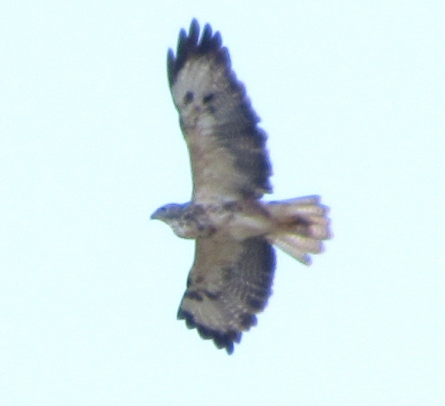
Warblington
shore
Peter
Milinets-Raby had the following highlights from a
couple of previous visits to the Warblington shore
over the past week:
Wed 13th Sept: 9am to 11am
There was an adult Yellow-legged Gull off Conigar
Point along with 5 Knot, 2 Dunlin and a Bar-tailed
Godwit
Langstone Mill Pond had 3 Sand Martin flying over,
along with 3 House Martin. A dozen Teal and 2 female
eclipse plumaged Shoveler.
Surprisingly there were no adult female Tufted Duck,
just 5 grown up young and a lost looking duckling,
that was diving happily on its own. Where has Mum and
his siblings gone?
Friday 15th Sept:1:40 to 2:30pm:
3 Greenshank, 8 Common Gull, 3 Bar-tailed Godwit and
10 Sandwich Tern off Pook Lane.
Over Langstone Mill Pond were another 4 Sand Martin
and two (on the verge of fledgling) Little Egret juvs
were still being fed.
There were 3 eclipse plumaged Shoveler (two females
and a male).
Farlington
Marshes
The Havant
Wildlife Group visited Farlington Marshes on Saturday
morning. Here are some of the highlights:
Bearded Tits,
Black-tailed Godwits fighting, Ruff, Yellow
Wagtails.
For the full report
see . . . Havant
Wildlife Group
TUESDAY
SEPTEMBER 12 - 2017
Nore
Barn
I went over to
Nore Barn this afternoon at about 1.30pm mainly to
look for the Spotted Redshank that has now been seen
by two people, Anne de Potier (Sep 5) and Peter
Milinets-Raby (Sep 9). In each of these two occasions
the Spotted Redshank was feeding with the regular
colour-ringed Greenshank (G+GL). If this was the
regular Spotted Redshank that has been feeding in the
stream at Nore Barn for the past 13 winters running
then it is some 3 weeks earlier than any previous
first sighting date.
For all the previous first and last sightings go to .
. . Spotted
Redshanks at Nore Barn
This afternoon, the
tide was rising to high water at about 4pm, so I was
quite hopeful of seeing the bird which I have missed
in previous visits this month. I stayed until about
2.30 by which time the tide was well advanced and
filling the small stream. A Common Redshank was
present for the whole period I was there and was
joined by the regular colour-ringed Greenshank
(G+GL) and they were feeding together quite amicably.
Here is a shot of
them bathing together in the shallow stream
and the Greenshank showing its rings when it came up
stream
But, alas, there was
no sign of the Spotted Redshank. I know the regular
Spotted Redshank usually takes a little while to
settle into a feeding routine after it first arrives,
so I am not entirely surprised about its non presence
today. However, the question remains, is it or is it
not our regular Spotted Redshank? Only time will tell.
I was interested to
see the new Nore Barn Woods interpretation
board on the edge of the south path by the shore.
The board is said to be a joint project of the
Chichester Harbour Conservancy and the Friends of
Chichester Harbour. It is nicely laid out with photos
of some of the wildlife that can be seen in the area,
including our old friend the Spotted Redshank!

There appears to have
been a bumper crop of Acorns this year. The
paths were strewn with fallen ones and there were
still plenty of fresh ones on the trees.
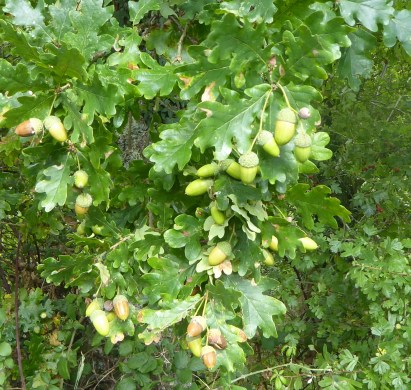
I happened to meet
Roy Ewing on the north path tending to the
Hawthorn hedge on the other side of the wire fence.
Roy explained that the landowners gave permission for
the group to plant the hedge inside the boundary
fence. The fence had the advantage of protecting the
new saplings as well as preventing dog walkers gaining
access to the field where Brent Geese feed in winter.
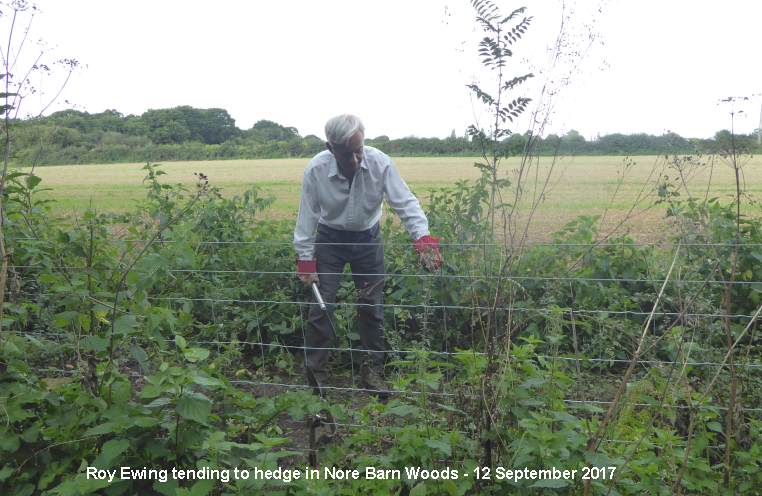
MONDAY
SEPTEMBER 11 - 2017
Purple
Moor-grass
The mystery
grass that Caroline French and I found in Southleigh
Forest yesterday was identified by John Norton, Ralph
Hollins and several Facebook correspondents as Purple
Moor-grass (Molinia caerulea). John
added that he found a tiny single stem the other day
with an unusually compact spike of flowers, and didn't
immediately recognise it. Then he remembered the
purple anthers = Purple Moor-grass!
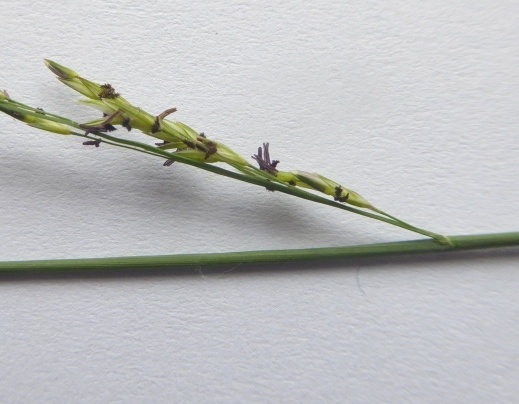
Purple Moor-grass is
native in the British Isles and occurs in most of
Europe and has been introduced into N America. It has
a wide range of habitats including open moorland,
heaths, grassland, bogs and open woodland, but the
common feature of all these habitats is the
permanently or seasonally wet ground ('Grasses of The
British Isles' by Cope and Gray).
Nostoc
alga
As for the
mass of soft squishy algae that Caroline and I found
in the forest, John Norton and Ralph Hollins thought
it looked like Nostoc commune which,
John says, is very common on gravel and concrete, etc.
wherever there is a bit of dampness. It is getting
very abundant at the moment due to all the rain.
Because of its similarity to Seaweed, Ralph calls it
Landweed adding that it suddenly appears en masse on
rocks (such as gravestones in churchyards) for a few
days then vanishes.

SUNDAY
SEPTEMBER 10 - 2017
Southleigh
Forest
I had a very
pleasant walk through Southleigh Forest with Caroline
French this morning despite the wet conditions. It was
just like the old days when we used to do the BTO Bird
Atlas surveys in SU71 together. Today, we walked along
the regular path used by Chris Berners-Price where he
has had the best sightings of Goshawks, but saw
nothing of special interest. We did hear a single
raptor-like call which could have been a Goshawk
calling. We also explored some of the other paths
through the woodland which I have not been along
before, but did not see anything special. However, we
both agreed the habitat is ideal for Goshawks, so we
shall try again. Caroline managed to pick up various
crest calls and saw a group of Long-tailed Tits.
We stopped to admire many interesting grasses, sedges
and rushes along the edges of the paths. One patch of
grasses in particular attracted my attention and I
picked a stem (85cm long) for identification at home -
see photo below. I have not yet been able to name it.
Can anyone help?
Here
are the grasses by the
path

Here
is a panicle with a close up of the
spikelets
We also saw some
really nice clumps of Hard Fern and some
Tutsan with black berries.
Probably the most
puzzling find was some soft algae which
Caroline thought she also saw on Hayling yesterday
during a walk with the HWT Flora Group. Anyone know
what it is?
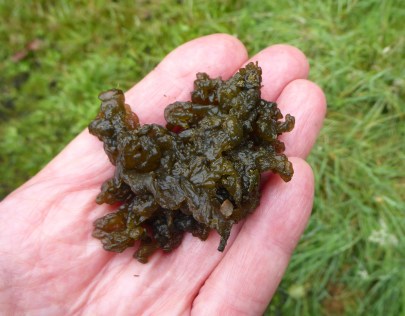
Several species of
fungi attracted our attention during the walk. An
attractive bright yellow one growing on a log covered
in green mosses is called Yellow Stagshorn
(Calocera viscosa). Another group of
fungi with pale cream caps and a strong mushroomy
smell were growing around the base of an old tree
stump - tentatively identified as The Miller
(Clitophilus prunulus), but I am far
from sure. Corrections welcome.
Greenshank
ringing
Anne de Potier
reports on a colour-ringing session yesterday in which
10 more Greenshanks were ringed with combinations all
with B//R on the left leg. Greenshank G//R+BR was also
caught and its geolocator tag removed for analysis.
Anne says, "We won't know for some time what the
geolocator tells us - but of course we do know that it
spends a lot of time off Langstone, thanks to all
Peter Milinets-Raby's reports. These definite
sightings help to validate the electronic
data."
Here
is a shot Peter Milinets-Raby got of G//R+BR with its
geotag
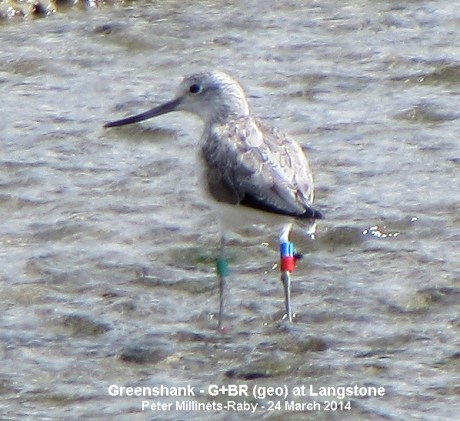
SATURDAY
SEPTEMBER 9 - 2017
Emsworth
to Warblington
Peter
Milinets-Raby was out this morning as the sun rose
(6:28am to 9:41am - low tide throughout) looking for
birds along the shoreline from Emsworth to
Warblington.
Emsworth Harbour: 6 Pied Wagtail, 7 Little Egret, 1
Canada Goose, 1 Greenshank, 1 Grey Heron, 1 Great
Black-backed Gull, 26 Turnstone, 1 Chiffchaff Heard
singing, 41 Black-tailed Godwit, 9 Dunlin, 4
Cormorant, 2 Grey Plover, 1 Common Tern, Redshank with
colour rings (-//G + G//YG).
Beacon Square: 26 Mallard and 34 Teal feeding on the
mud at first light. 6 Pied Wagtails
Nore Barn (from 7:28am): Redshank with colour rings
(-//O + O//BY), 2 Greenshank and 1 Spotted Redshank
feeding together. 76 Teal.
Ibis Field (from 7:40am): 5 House martin, 3 Swallow, 2
Yellow Wagtails heard flying over.
Hedgerow behind Conigar Point: 9+ Chiffchaff along
hedgerow, Garden Warbler (My second ever
record).
Conigar Point (from 8:13am): 8 Yellow Wagtails
flew over, 2 Common Tern, 2 Common Gull, 1 adult
winter Med Gull with white ring - too far to read, 1
Greenshank, 1 Grey Plover, 1 Shelduck.
Tamarisk Hedge: 11+ Chiffchaff, 3+ Willow Warbler.
SSSI Field/Hedge: Two pairs of Yellow Wagtails
in amongst the cattle and showing well (see photos
of adult male and adult female - the female having
some characters of a possible flava - the other pair
female was more typical with paler appearance, with
nor hint of any bluish tinges - such a difficult group
to sort out).
1 Lesser Whitethroat,
1 Whitethroat, 4 male Blackcaps, 2 Meadow Pipit.
Pook Lane: 1 Common Tern, 13+ Swallow, 4 Linnets, 1
Dunlin. In hedge 2 more Whitethroats.
Adder
in Havant Thicket
Pam and Roy
Ewing had a walk around the perimeter of Havant
Thicket today and tripped over an Adder literally) and
then a few yards on, a Slow-worm. Both were basking in
the fine sunshine, probably drying out after
yesterday's deluge! Wow, what a find and a cracking
photo.
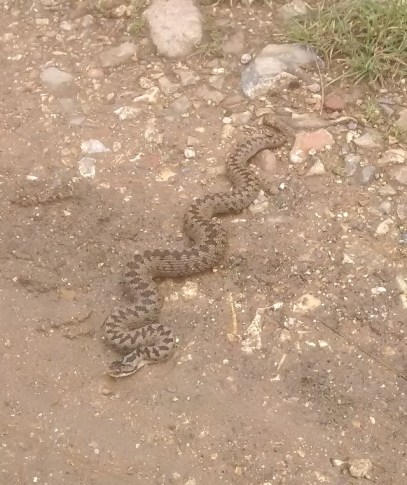
Havant
Thicket
Heather Mills
reported on this morning walk by the Havant Wildlife
Group. Among their sightings were two species of
Hawkers: Southern Hawker and Migrant Hawker
For Heather's full
report go to . . . http://familyfellows.com/hwg-walk-reports-2017.htm
FRIDAY
SEPTEMBER 8 - 2017
Goshawk
in Southleigh Forest
Chris
Berners-Price went for a last walk today in the forest
before his 2 weeks holiday. Having not seen anything
at all yesterday, his luck changed dramatically today.
He was about to give up and started to walk for home
and there she was - a female Goshawk flying away from
him, 50 yards to 150 yards away, 10 feet up - a
massive bird, beautiful solid colour on her back (dark
brown/battleship grey) then she flew up into the trees
near the road - amazing!
Chris takes up the story, "I followed her up towards
the road and scanned the trees, but it started to rain
so I went along the path (that we have not been on)
that goes from the bicycle track/road junction,
parallel to the road, back to where the cars are
parked. About 100 yards along there, when..... I heard
motion above me and she flew out of the tree above
me!!! I could even see the tiny bit of white on the
end of her tail feathers. I have absolutely no doubts
whatsoever now. I am still buzzing!"
He did not get any
photos, but sends a couple of Goshawks from the
internet. The first photo shows the male colour. The
female looks more like the second photo - a solid
block of colour that changes if you see her in light
or shade. As he always sees the backs of the wings as
they fly away, he will look for the white tip to the
tail now.
Langstone
shore birds
Peter
Milinets-Raby's recent commitments has made it
difficult for him to get good quality bird watching
time in along the Langstone shore. So, he sends a
summary of 20 minute visits over the past three of
days, two of them at high tide:
Wednesday 6th:
From Beacon Square, lunchtime at high tide: 15 Little
Egrets roosting in the marsh, 3 Sandwich Tern, 2
Common Tern, 1 Hobby flew south out into the
harbour.
Thursday 7th:
Langstone Mill Pond early afternoon - high tide: 61
Little Egrets roosting out the high tide, 1
Chiffchaff, 10 Teal, 2 Shoveler, 3 Sandwich Tern
offshore fishing.
Friday 8th:
Langstone Mill Pond at 9 am - low tide: 2 Greenshank,
5 Grey Plover, 14 Dunlin, 3 Black-tailed Godwit. On
the pond were 10 Teal, 3 eclipse Shoveler and a female
Wigeon!? And one solitary House Martin swooping over
the pond, looking like something rare!
Chiffchaff
is a Willow Warbler
Steve Hooper
pointed out that the photo of the Chiffchaff taken by
Brian Lawrence's grandson in yesterday's blog looks
rather more like a young Willow Warbler. The
supercilium is very bright, and the wings look a bit
long for a Chiffchaff. There is also a hint of light
pink or brown in the legs and feet, whereas he would
expect the legs of a Chiffchaff to look much
darker.
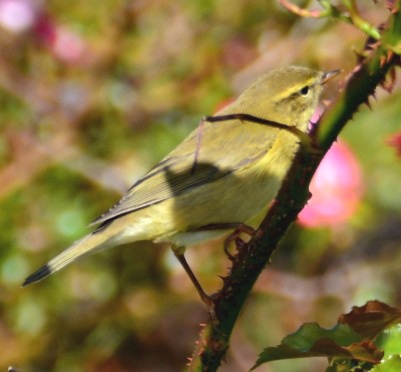
THURSDAY
SEPTEMBER 7 - 2017
Nore
Barn
I went over to
Nore Barn at 10am with the tide rising to high water
in 3 hours. This is the state of tide when Anne de
Potier saw the Spotted Redshank with the regular
colour-ringed Greenshank (G+GL) on Sep 5. When I
arrived the tide was still a bit low and only the
Little Egret was feeding in he stream. I had a walk
round and returned before 11am to find the regular
colour-ringed Greenshank (G+GL) feeding happily in the
stream with a Common Redshank. There was no sign of a
Spotted Redshank.

PS: Anne added she was
in no doubt about the Spotted Redshank ID, size, bill,
legs, behaviour etc. Also there were a number of
Common Redshanks in the area at the time she saw the
Spotted Redshank.
Goshawk
in Southleigh Forest
Chris
Berners-Price got another good view of what surely
must be the female Goshawk in Southleigh Forest this
morning. It was just past the kill site and towards
the motor cycle path. He described it thus: "A very
large bird crossed ahead of me from right to left,
only 15-20 yards ahead flying lazily through the pines
at about 15 feet up. Huge bird, bigger than a Buzzard,
solid-colour battleship grey and brown above. It then
turned just as I lost sight of it and got a flash of
white from underneath at the back of the
wings."
Brian's
news
In the past
week Brian Lawrence has been going around Brook
Meadow, Emsworth Harbour and Hayling Oysterbeds and
got some interesting shots. A lovely Wren in Brook
Meadow. Juvenile (1st winter) Dunlin at the
Oysterbeds.
A large flock of
Oystercatchers roosting at the Oysterbeds
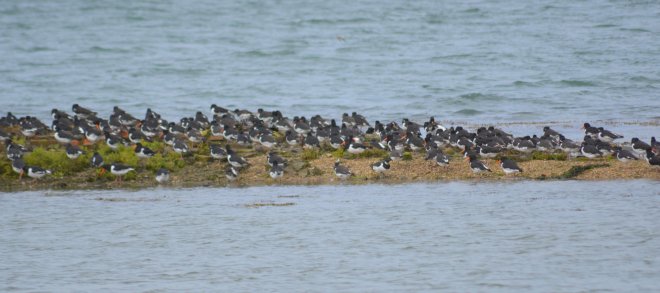
Brian also caught up
with the Emsworth Mute Swan family still with their 5
cygnets in the harbour.

Finally, Brian's
grandson (no age given) got a nice photo of what looks
like a Chiffchaff.
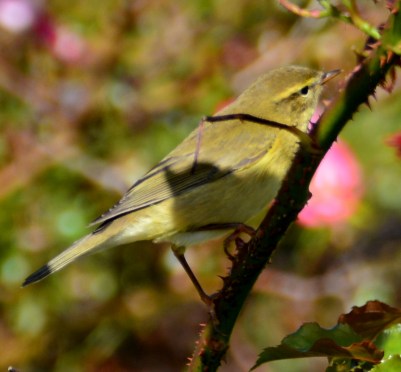
Ivy
in flower
This morning
Ralph Hollins found two patches of Ivy in full flower
during his walk on Hayling Island. They were buzzing
with insects including a hoverfly Hornet mimic
(Volucella zonaria) but no Wasps. Ralph
says they seem to be scarce this summer.
Here
is a photo ,I got of a Hornet mimic (Volucella
zonaria)
on Brook Meadow a couple of years ago. Striking
insects!
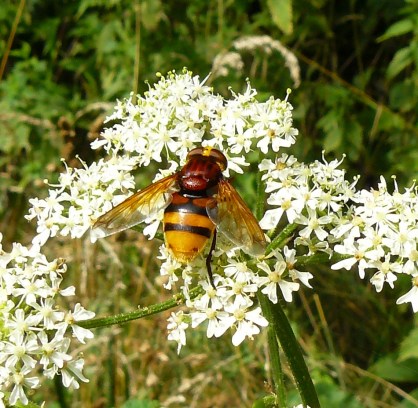
WEDNESDAY
SEPTEMBER 6 - 2017
Goshawks
in Southleigh Forest
I met Steve
Hooper at 10.30am as arranged at the parking lay-by on
the Emsworth Common Road for our walk through the
woods to look for Goshawks. We walked to the end of
the path that Chris Berners-Price has seen the
Goshawks recently as far as the cycle track and the
'Private Keep Out' notice. Steve was a great fund of
information about Goshawks and their behaviour. Here
is a shot of Steve demonstrating the wing span of a
female Goshawk. That is some bird!

We saw no sign of
Goshawk, but Steve said it was not unusual for
Goshawks to go quiet for several days. But he thought
the habitat of tall erect trees with no undergrowth in
Southleigh Forest was ideal Goshawk habitat. These
large birds needed space between trees to pursue their
prey. The tall firs with dead branches in particular
made ideal perches to search for prey. He seemed to
have little doubt that the birds Chris Berners-Price
has been seeing are Goshawks.
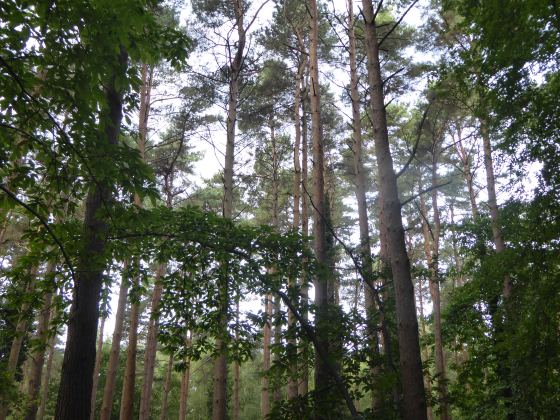
We cut across to the
official bridleway and walked down to the Emsworth
Common Road. On the way I spotted more Hard Fern
beside the path. We crossed the road and made a slight
diversion back to the cars through Hollybank Woods. We
stopped briefly to admire a fine growth of Heather
by the bridleway.
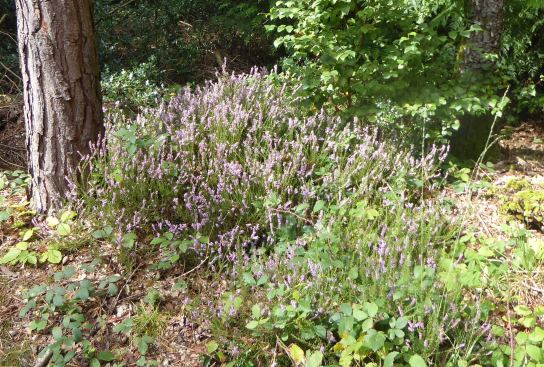
We also had a look
around young Andrew's very impressive woodland
workshop behind the Lorton seat with numerous neat
piles of sticks and various other constructions. Pity
Andrew himself was not present to explain his work to
us.
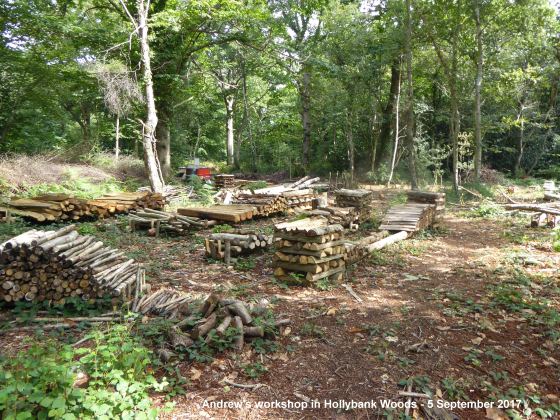
Nore
Barn
After lunch I
went down to have a look for the Spotted Redshank that
Anne de Potier saw in the Nore Barn stream yesterday.
The tide was falling and by 3.30pm the stream was
fairly low. But there was no Spotted Redshank or
Greenshank, only a Little Egret. I was
interested to see its feeding technique of leaving the
tip of its bill just under the level of the water,
presumably waiting for passing fish.
On the way back I
spotted a good growth of Lesser Sea-spurrey on
the edge of the saltmarshes near the picnic table.

TUESDAY
SEPTEMBER 5 - 2017
Southleigh
Forest
This
afternoon, I decided to do a walk through Southleigh
Forest to look for Goshawks. It was raining lightly
throughout the walk, making the paths a bit muddy, but
still quite walkable with wellies. I walked to the end
of the main path where Chris Berners-Price had
reported seeing the Goshawks and back without seeing a
thing. All I heard were several Jay's calling. With
raindrops pattering down on the woodland floor, I
paused several times peering through an army of tall,
erect, trees, without seeing anything of
ornithological interest.
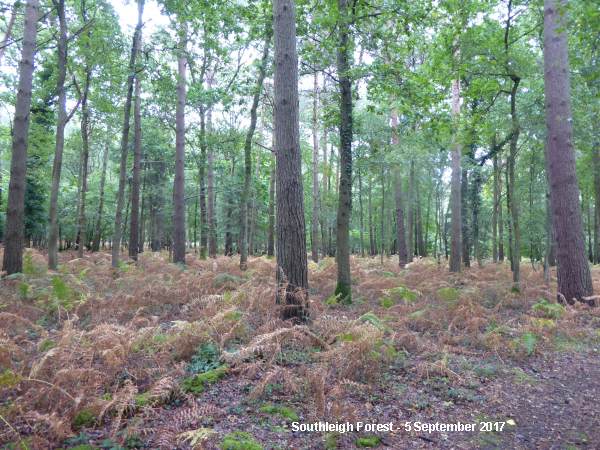
I met Chris
Berners-Price on his regular afternoon walk, but he'd
seen nothing as well. He wondered if the Goshawks may
have moved somewhere else. Maybe, as they have not
been seen for a week. Regarding Tom Bickerton's
comment in yesterday's blog that Goshawks like to take
their prey to a favoured spot, Chris made the point
that the kill was smack-bang on top of a small mound
with good all round visibility, indicating that the
bird had placed it there before it was eaten. Here is
a photo of the (green) site that I took today.
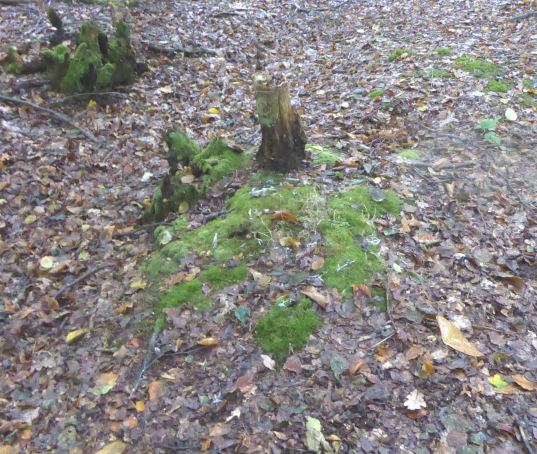
I was interested to
see a fine growth of Wood Spurge and a tuft
what I think might be Hard Fern.
Spotted
Redshank returns?
This morning
Anne de Potier saw a Spotted Redshank in the stream at
Nore Barn along with the regular colour-ringed
Greenshank (G+GL). If this was the same Spotted
Redshank that has been visiting Nore Barn for the past
13 years, it would be the earliest arrival date on
record. The previous earliest date was 27 Sep in 2015.
How exciting.
Here
is one of the last shots we got of the famous Spotted
Redshank in the Nore Barn stream
before it left on migration to Northern Scandinavia in
March this year.
Photo by Peter Milinets-Raby (16 March
2017).
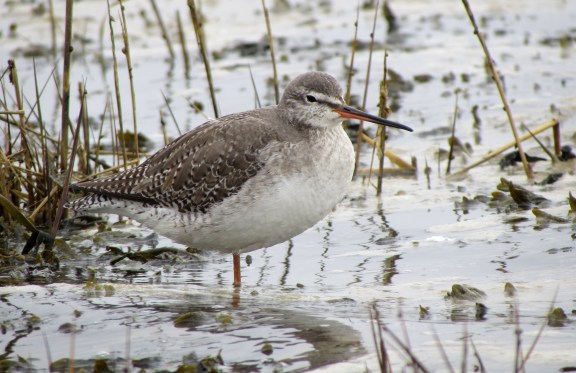
MONDAY
SEPTEMBER 4 - 2017
Langstone
Mill Pond
Peter
Milinets-Raby had two trips to Langstone Mill Pond
today. One as the tide pushed in to high (9am to
10:46am) and another later in the day as the tide
dropped (2pm to 3:47pm)
Early visit:
Pond: Amazingly there are two broods of Tufted Duck
ducklings. Two females with 5 ducklings each, the
second brood looking about a week old (see photo). the
earlier brood are beginning to grow up, but have lost
a couple of brothers/sisters.

4 Teal, 4 eclipse
plumaged Shoveler, 26+ Swallows, Cetti's Warbler
heard, 15 Little Egret roosting out high tide, 70+
Goldfinch, 3 House Martin, 1 Kestrel, 1
Sparrowhawk.
Off shore: 2 Teal, 2 Dunlin, 3 Black-tailed Godwit, 3
Sandwich Tern, 1 Grey Plover, 2 Common Sandpiper, 9
Greenshank (G//R + LL//-),
Off Conigar Point: 2 Greenshank, 25 Grey Plover, 2
Ringed Plover, 4 Shelduck.
Later:
Off shore: 16 Ringed Plover, 32 Dunlin, 2 Greenshank
(G//R + BRtag//- see photo), 74 Redshank (-//B +
B//YG), 23 Grey Plover, 1 Black-tailed Godwit,
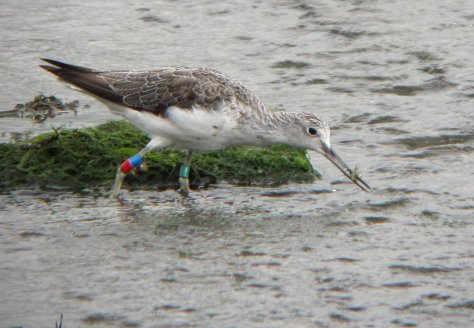
Off Conigar Point: 5
Knot, 1 Turnstone,
And further in the distance in Emsworth harbour: 6+
Common Tern, 3 Black Tern - tiny grey specks in
the scope on 60x magnification!!! 1 Great Crested
Grebe
More
on Goshawks
Tom Bickerton
has written to say that there is every likelihood that
Chris Berners-Price did see a Goshawk in Southleigh
Forest. He adds, "Goshawk is not easy to find at all,
so he did well. The Forest is perfect for them with
lots to eat. I did manage to see a female Goshawk a
few years back, further north by Finchdean, which took
me by surprise".
As for the kill, which Chris and I thought might have
been by a Goshawk, Tom thinks this was more likely to
be a Sparrowhawk kill. A Goshawk would have easily
carried the kill away and it looks too messy. Goshawks
take prey to a favoured spot.
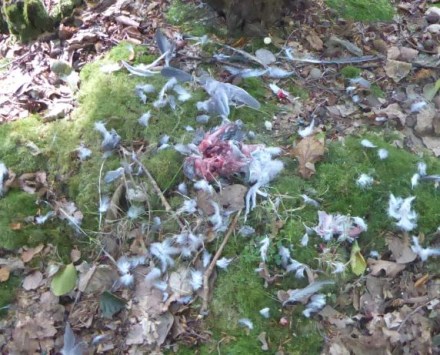
As for the feather
that Chris found, Tom confirms it was from a Buzzard.
Adult Goshawks have an inverted 'V' along the
spine.
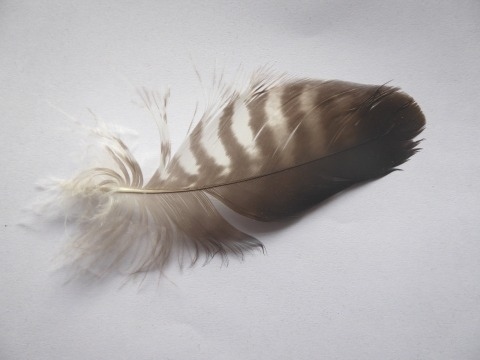
SUNDAY
SEPTEMBER 3 - 2017
BROOK
MEADOW
Work session
I went over to
the meadow this morning for the regular first Sunday
in the month work session. Rain was forecast which
probably accounted for the relatively small number of
volunteers - 9 turned up. We welcomed three new
members - John and Laura Brind and Terry Lay. The
session was led by Dan Mortimer. The main task was to
cut and clear the orchid area on the north meadow.
Maurice, Jennifer and Phil took it in turns to use the
power scythe to cut the area. I asked the cutters to
leave clumps of still flowering plants as nectar
sources for late flying insects.
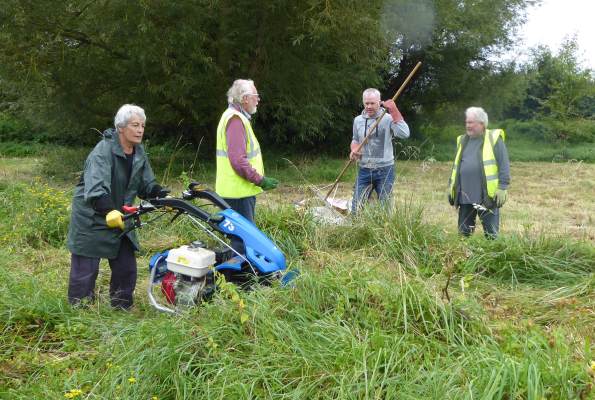
The hard work of
raking, clearing and hauling to the dump was done by
the rest of the team.
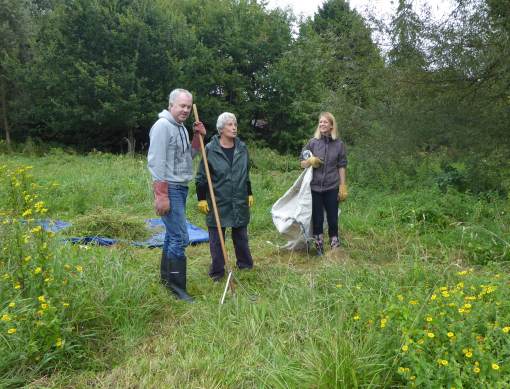
In Pam's absence
Jennifer provided tea, coffee and biscuits ably
assisted by Laura.

There are more
photos of the work session on the Brook Meadow web
site at . . . http://www.brookmeadow.org.uk/conservation-news/
Wildlife
observations
Two ecologists
were carrying out a reptile survey during the work
session, checking the black mats for reptiles.
Apparently, they found 1 male and 3 female Slow-worms
and one baby, but no Common Lizards.

Here is a female
Slow-worm identified by a dark stripe down its back -
not clearly visible in the photo.
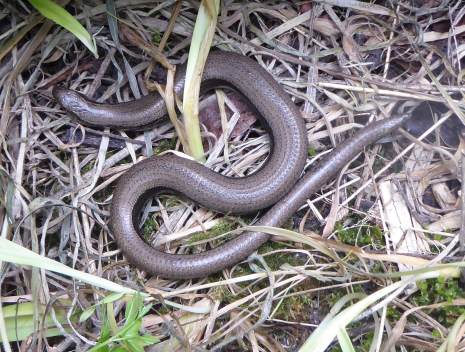
During the cutting of
the orchid area, Maurice pointed out a solitary
seedhead spike of a Common Spotted Orchid. We had a
good showing of orchids this year, so let's hope for
more next year.
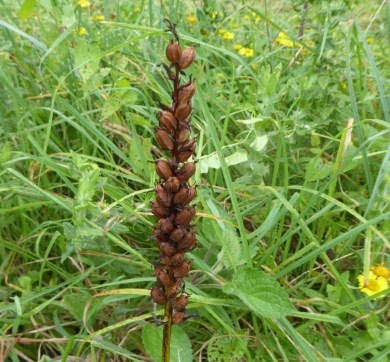
Mystery
caterpillar is Red Admiral
Andrew Brown
came to the rescue to identify the mystery caterpillar
found yesterday by the Havant Wildlife Group during
their walk at Testwood Lakes. The larvae is a pale
form of Red Admiral.
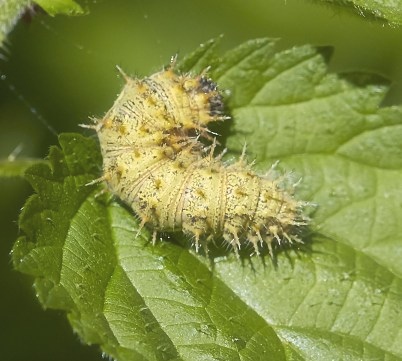
The caterpillar feeds
on Common Nettle leaves and lives hidden in a tent of
one or several leaves folded over and fastened
together by silk. No wonder I have never seen one!
When fully grown it is plump, spiny and very variable
in colour from light to dark. The chrysalis hangs
suspended inside the caterpillar's last tent. The
emerging adult feeds and flies around. Most perish in
winter, but some manage to survive and can be seen
fluttering around on warm days in mid winter.
SATURDAY
SEPTEMBER 2 - 2017
Southleigh
Forest
I met Chris
Berners-Price at 9am for another walk through this
fine area of woodland north of the Emsworth Common
Road. It was a sunny morning, but chilly in the woods.
It was such a good experience to walk along the paths
with the low sun shining through the trees.
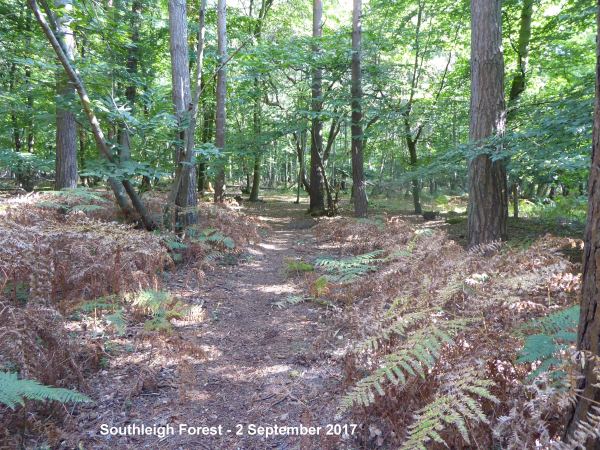
We looked and listened
for any sign of Goshawks, but did not see anything.
However, we did find that the half-eaten kill we saw
yesterday had gone, leaving only a scattering of
feathers. We assumed the hawk returned to finish its
meal after we had left.
The main feature of
the morning were the Fallow Deer which were
racing around the woods in fairly large herds; I
counted a good 15 in one group. The bucks were barking
loudly, what a strange sound that is. I got a photo of
one doe peering at me through the trees.

I was interested to
see lots of Tormentil in flower along the edges
of the paths. All seemed to have the standard four
yellow petals, though I gather five petals are not
uncommon in certain habitats.

Brent
Geese are due
Ralph Hollins
has been going through the records of Brent Geese for
the past few years and concludes the time to look for
the first migrants is the second week of September on
a day with a morning high tide. See his diary for Wed
Aug 30. http://ralph-hollins.net/Diary.htm
I would add that
locally I always expect to see the first Brent
arrivals in the south east corner of Langstone Harbour
near the Sinah Warren holiday complex.
Ralph also gives a
link to a useful document written from the perspective
of an Essex birder but well worth reading by anyone
interested in the three Brent species (Dark-bellied,
Pale-bellied and Black Brant). At the very end of this
document is a map of the route they take between their
breeding grounds in Siberia and the British Isles.
See . . . http://www.allaboutmigration.com/about-brent-geese/
Testwood
Lakes
Valerie
Mitchell reported on this morning's walk by the Havant
Wildlife Group. Among their sightings were Migrant
Hawker, Ruddy Darter and a mystery caterpillar.
For the report and
more photos go to . . . Havant
Wildlife Group
FRIDAY
SEPTEMBER 1 - 2017
Goshawks
in Southleigh Forest
I previously
reported (Aug 27) that my friend Chris Berners-Price
has seen what he thinks is a Goshawk in Southleigh
Forest. Since then Chris has had good views of two
Goshawks, a small male and a large female, in the same
area of the woods. Grid Ref: SU745091. Goshawk is a
rare bird which, as far as I am aware, has not
previously been reported in our area. However, The
Hampshire Bird Atlas states that Goshawk is an
increasingly common resident of the larger forests,
especially the New Forest so this pair is not entirely
unexpected. Also, the Sussex Bird Report for 2015
reports up to 4 or 5 breeding pairs in West Sussex, so
they are getting closer!
Today, I decided to
accompany Chris on his regular morning (9.15-10.15)
and afternoon (3.30-4.30) walks through Southleigh
Forest, partly to confirm the location of the
sightings and hopefully to get a sighting of the birds
myself. Chris has been walking these complex uncharted
woods daily with his dog since the spring and knows
them very well. A maze of fairly well trodden
footpaths run through the woods, but as I am not very
familiar with the woods, I appreciated Chris's
guidance. On each walk we took a circular route
starting at the parking area on Emsworth Common Road
opposite the north entrance to Hollybank Woods and
headed north towards Woodberry Lane. Today, the
woodland looked particularly beautiful in the late
summer sunshine.
Here is a shot of
Chris walking along one of the paths with his
well-behaved dog on a lead

Southleigh Forest is a
mixed unmanaged woodland with trees of varying ages,
similar to those of Hollybank Woods on the other side
of Emsworth Common Road. Chris thinks it is owned by
Havant Borough Council, though I think it used to
belong to Southern Water. The western area is
privately owned and has many 'Keep Out' notices. There
is one official public bridleway on the east side that
runs from Emsworth Common Road to Woodberry Lane. We
went around all the 'hot spots' where Chris has had
sightings of the Goshawks.
Here is a shot of
Chris looking out for Goshawks

We did not see
anything in the morning visit, but in the afternoon we
got a fairly good view of what Chris thought was the
male Goshawk leaving a kill. I did not see the bird
clearly enough to judge. We searched the local area
with our bins, but did not get any further sightings.
However, we did find the kill, which was a fresh
half-eaten pigeon which we left it as it was for the
hawk to finish off.

In a previous visit
Chris found a feather which 'floated down from a tree'
which he thought might be from a Goshawk, but it looks
more like a Buzzard primary to me.
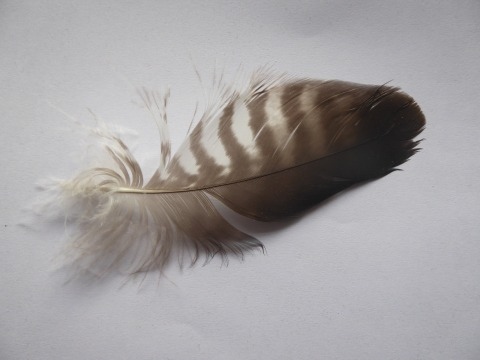
Langstone
Mill Pond
Peter
Milinets-Raby has just returned from an evening visit
to Langstone Mill Pond 6:30pm to 8:27pm Tide nearly
in. Disappointing count of 144 Little Egrets coming in
to roost.
Other birds of note were Cetti's Warbler singing, 9
Greenshank, 14 Dunlin, a Black-tailed Godwit and 160+
Swallow coming in to roost.
For
the previous month go to . . . August
1-31